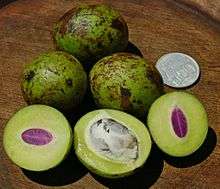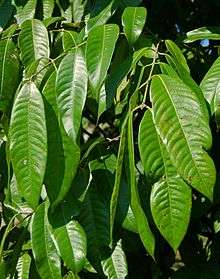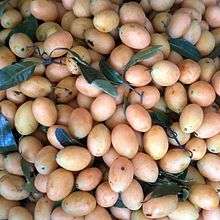Bouea macrophylla
| Bouea macrophylla | |
|---|---|
| | |
| Immature Bouea macrophylla in a basket | |
| Scientific classification | |
| Kingdom: | Plantae |
| (unranked): | Angiosperms |
| (unranked): | Eudicots |
| (unranked): | Rosids |
| Order: | Sapindales |
| Family: | Anacardiaceae |
| Genus: | Bouea Meisner, 1837 |
| Species: | B. macrophylla |
| Binomial name | |
| Bouea macrophylla Griffith | |
Bouea macrophylla, commonly known as gandaria in english, is a species of flowering plant native to Southeast Asia. The tree belongs to the Anacardiaceae family which also includes mango and cashew.
Description


The evergreen tree grows to heights of 25 meters. Its leaves are lanceolate to elliptic in shape (see: Leaf shape), and range from 13 to 45 cm (5 to 17 inches) long and from 5 to 7 cm (2 to 3 inches) wide.
The fruit (resembling a mango) are green in colour and mature to an orange/yellow, with the seed being pink. They grow to roughly 2 to 5 cm (0.7 to 1.9 inches) in diameter. The entire fruit, including its skin is edible. The fruit range from sweet to sour in flavour, and have a light smell of turpentine.
Flowering and fruiting times differ for Thailand and Indonesia.
- Thailand : flowers in November to December, and fruit appears from April to May.
- Indonesia : flowers in June to November, and fruit appears from March to June.
Distribution
The tree is native to Malaysia, West Java, Burma and North Sumatra. It is also found in Thailand, Laos, Indonesia, and Malaysia, where it is commercially grown.
Naturally, it can usually not be found above an altitude of 305 meters (1000 ft), but has been cultivated at altitudes of about 850 meters (2789 ft).

Uses
Consumption
Both the leaves and fruit from the tree can be eaten. The leaves can be eaten raw when they are still young, and can be used in salads. While the seed is edible, the endosperm is generally bitter. Fruit can be eaten raw, or made into dishes such as pickle, compote, or sambal. Unripened fruit can be used to make rojak and asinan.[1]
Functional
The entire tree can be used as an ornamental fruit bearing shade tree due to its dense foliage.[2]
Other names
Bouea macrophylla is commonly known in English as the "marian plum", "gandaria", and "plum mango". It is also known in Thai as ma bpraang (มะปราง) and ma-yong; in Indonesian as ramania and gandaria; in Burmese as mayun-thee; and in Vietnamese as thanh trà
In Malay, the tree is known as kundang, rembunia, and setar, and is the origin of the toponym Alor Setar (with alor meaning "small stream").
References
- ↑ "West Australian Nut and Tree Crops Association". WANATCA Yearbook (ISSN 0312-8997), Vol. 20, p. 42 (1996).
- ↑ TopTropicals plant catalog
Sources
Bouea macrophylla taxonomy
Montoso gardens
Species with potential for commercial development
Mansfeld database
AgroForestryTree Database